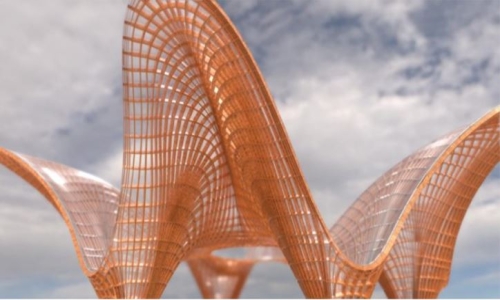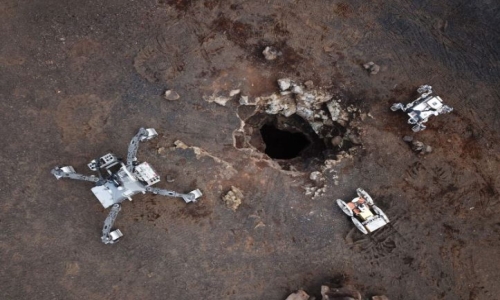


 4:38:17
4:38:17  2023-10-17
2023-10-17  1261
1261

The Fly Geyser, located in Nevada, USA, is a breathtaking geologic wonder that has captured the imagination of scientists, nature enthusiasts, and travelers alike. Unlike other natural geysers that formed over millions of years through natural processes, Fly Geyser is an accidental creation that resulted from human activities. What started as a well drilling operation in 1916 turned into a fascinating phenomenon with its unique features, including its vibrant colors, terraces, pools, and ever-changing landscape.
Fly Geyser is known for its stunning display of red, green, and white hues, which are caused by thermophilic algae thriving in the hot, mineral-rich water that continuously flows from the geothermal reservoir. The resulting cone-shaped mound, covered in in mineral deposits and adorned with vibrant colors, makes Fly Geyser a visually captivating sight.
Beyond its visual appeal, Fly Geyser also holds scientific significance. The geothermal processes, mineral deposition, and microbial life associated with Fly Geyser have been the subject of scientific study, providing insights into the unique geological and ecological processes at play. Furthermore, Fly Geyser’s remote location and protected status have spurred conservation efforts to preserve this delicate natural wonder for future generations.
Although Fly Geyser is located on private land and not open to direct public access, guided tours are available for visitors to appreciate its beauty from a distance and learn about its geologic significance and conservation efforts. As we delve deeper into the geologic wonder that is Fly Geyser, we will explore its formation, unique features, environmental significance, scientific study, and accessibility, revealing the marvels of this accidental gem in the Nevada desert.
Fly Geyser is located in the remote Black Rock Desert of northwestern Nevada, USA, approximately 20 miles north of the town of Gerlach. The Black Rock Desert is known for its arid, desert-like conditions with sparse vegetation and a harsh climate. The geyser is situated on private land owned by the Fly Ranch, which is not open to direct public access.
The significance of Fly Geyser lies in its unique formation, accidental creation, and distinctive features. Unlike natural geysers that form over millions of years through natural geothermal processes, Fly Geyser was accidentally created during a well drilling operation in 1916. The drilling was done to explore sources of geothermal energy, but the well was not properly capped, leading to the continuous flow of hot water and minerals that eventually formed the geyser.
Fly Geyser is renowned for its stunning and vibrant colors, which are a result of thermophilic algae thriving in the hot, mineral-rich water. The algae create a mosaic of red, green, and white hues that cover the geyser’s cone-shaped mound, terraces, and pools, making it a visually striking natural wonder.
Additionally, Fly Geyser’s ever-changing landscape, shaped by ongoing mineral deposition and geothermal activity, adds to its uniqueness. The constantly evolving features, combined with the geyser’s accidental formation and remote location, have drawn the attention of scientists, researchers, and nature enthusiasts alike.
Furthermore, Fly Geyser’s ecological significance is noteworthy. Despite its harsh environment, the geyser supports a diverse range of plant and animal species that have adapted to its unique geothermal conditions. As a result, the geyser has become a subject of scientific study, providing insights into geothermal processes, mineral deposition, microbial life, and ecosystem dynamics.
Finally, Fly Geyser’s protected status and conservation efforts highlight its significance as a fragile natural wonder that requires careful preservation. The Fly Ranch, which owns the land where the geyser is located, has implemented measures to protect and conserve the site, limiting public access to guided tours to minimize human impact.
In summary, Fly Geyser’s location in the remote Black Rock Desert of Nevada, its accidental creation, distinctive features, ecological significance, and conservation efforts collectively contribute to its significance as a captivating geologic wonder that has attracted attention from various perspectives, including scientific, ecological, and conservation.
The formation of Fly Geyser is a unique and accidental process that began with a well drilling operation in 1916. The geyser is located in the Black Rock Desert of Nevada, USA, and its formation is closely tied to the underlying geology and hydrogeology of the region.
The Black Rock Desert is characterized by a thick layer of sedimentary rocks, including layers of volcanic ash, lava flows, and tuff deposits. These sedimentary rocks contain layers of geothermal water that is heated by the underlying volcanic activity and geothermal heat sources.
The formation of Fly Geyser started when a well was drilled in 1916 to explore sources of geothermal energy. However, the well was not properly capped, and the hot water and minerals beneath the surface started to rise and escape through the uncapped well, creating a small hot spring. Over time, the continuous flow of hot water and minerals built up layers of travertine, a type of limestone, around the wellhead, forming a mound that eventually grew into a cone-shaped structure.
The mineral-rich hot water, with temperatures reaching up to 200°F (93°C), also provided ideal conditions for thermophilic algae to thrive. These algae create a vibrant display of red, green, and white hues on the travertine deposits, adding to the unique appearance of Fly Geyser.
As the hot water continues to flow and deposit minerals on the surface, the mound of travertine continues to grow, shaping the terraces and pools that adorn the geyser. The ongoing geothermal activity and mineral deposition, coupled with the growth of thermophilic algae, contribute to the ever-changing landscape of Fly Geyser, making it a dynamic and fascinating geologic phenomenon.
It’s worth noting that the accidental formation of Fly Geyser is different from natural geysers, which form through natural geothermal processes over millions of years. Nevertheless, Fly Geyser’s unique formation process and resulting features have made it a captivating geologic wonder that continues to intrigue scientists, researchers, and visitors alike.
Reality Of Islam |
|

A new NURBS

A research

Researchers
 9:3:43
9:3:43
 2018-11-05
2018-11-05
10 benefits of Marriage in Islam
 7:5:22
7:5:22
 2019-04-08
2019-04-08
benefits of reciting surat yunus, hud &
 9:45:7
9:45:7
 2018-12-24
2018-12-24
advantages & disadvantages of divorce
 11:35:12
11:35:12
 2018-06-10
2018-06-10
 6:0:51
6:0:51
 2018-10-16
2018-10-16
bahlool & the throne of haroun rashid
 8:20:35
8:20:35
 2018-06-21
2018-06-21
 9:42:16
9:42:16
 2022-10-19
2022-10-19
 6:14:3
6:14:3
 2023-01-18
2023-01-18
 3:18:29
3:18:29
 2022-12-24
2022-12-24
 8:30:23
8:30:23
 2022-03-03
2022-03-03
 5:57:34
5:57:34
 2023-03-18
2023-03-18
 7:32:24
7:32:24
 2022-02-14
2022-02-14
 5:41:46
5:41:46
 2023-03-18
2023-03-18
| LATEST |